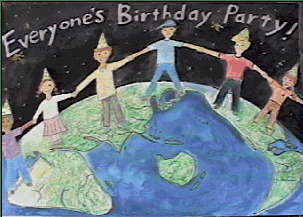
latest edition, Summer 2003
Unit plan and student surveys

Introduction
Have you ever thought about how everyone's
birthdays are connected? Just think, if your grandmother wasn't born, your
mother or father wouldn't have been born, and you wouldn't have been born? If
you think back even further, there's an infinite number of birthdays connected
to our own, our parents, and our grandparents, connecting us all around the
world and even into the stars! After reading this story, you might even agree that a star's
birthday is connected to your own! Sound cool?!
Think of this story as a birthday adventure that begins when a six year
old friend at his birthday party realizes that there is the number of people
around the table -- six -- is the same as his new age. As we enjoy his birthday
adventure, we'll learn
some more words in Japanese and hopefully see how our birthdays are connected!
Here's some new English and Japanese to learn before we go to the party:
When is your birthday?
Anata no tanjyoobi wa itsu desuka?
Practice answering the question by using the right month and day for your birthday in your answer.
January (ichi-gatsu), February (ni-gatsu), March (san-gatsu), April (shi-gatsu), May (go-gatsu), June (roku-gatsu), July (nana-gatsu), August (hachi-gatsu), September (ku-gatsu), October (juu-gatsu), November (juuichi-gatsu), December (juuni gatsu).
Just add the word, nichi after you say the month and one of the following numbers for the day of your birthday ("nichi" means "day") For example, my birthday is July 5th, so I would say, "sichi-gatsu, go-nichi." Try it !
| 1. ichi 2. ni 3. san 4. shi (yon) 5. go 6. roku 7. sichi (nana) 8. hachi 9. kyuu 10. jyuu |
11. jyuu-ichi 12. jyuu-ni 13. jyuu-san 14. jyuu-shi 15. jyuu-go 16. jyuu-roku 17. jyuu-nana 18. jyuu-hachi 19. jyuu-kyu 20. ni-jyuu |
21. ni-jyuu-ichi 22. ni-jyuu-ni 23. ni-jyuu-san 24. ni-jyuu-yon 25. ni-jyuu-go 26. ni-jyuu-roku 27. ni-jyuu-nana 28. ni-jyuu-hachi 29. ni-jyuu-kyu 30. san-jyuu 31. san-jyuu-ichi |
Got it?
If you do, then try another phrase that you could use real quick:
Have you every been to a birthday party?
Tanjyou pa--ti ni itta koto ga arimasuka?
Birthday parties are not celebrated as often in Japan as they are in America. Most of the time, the party is at home with close family. Many Japanese kids have never been to a birthday party for a friend outside of homeroom parties at school. (In most Japanese public schools, kids do many things in their homerooms -- they have their own homeroom meetings in the morning and afternoon, they organize work groups for cleaning the room, windows, hallways, bathrooms; they serve lunch and they plan for big events several times a year. And many homerooms have birthday parties once a month.
Are you ready to go to a big birthday party
now?
All right, here we go!
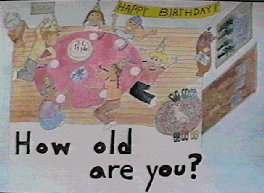
This birthday party is at night at the birthday boy's home. If you want to go to the party, try to imagine that you are one of the people in the picture. You can even be the dog if you want!
And when you get to the party, you want to be able to ask everyone how old they are don't you? In Japanese, it's "Anata wa nan sai desuka?" Practice the question with a friend by answering with the right number for your age. Just add the words, "sai desu" after the number you pick from the chart we just used above. For example, in English, I would answer, "37 years old," so in Japanese it would be "san-jyuu-roku sai desu." If your older than thirty-something, then you can still figure out how to say it by following the same pattern for making numbers. If you are ninty-nine years old, it would be kyu-jyuu-kyu; but if your over a hundred years old, you would have to say a hundred, or "hyaku," before you added on however many years older you are than a hundred. Try it!
The birthday boy in the picture just turned six years old and it turned out to be one of the greatest birthday parties ever. Was your last birthday your best birthday ever? Because the boy in the picture wrote about his birthday in his journal for his teacher, we can all read about it now. (In Japanese schools, for the first few six years of school students are required to keep a journal which the teacher reads and writes messages back daily.) This is what the boy wrote in his journal about his birthday party:
Today was my birthday, and I had a Birthday Party! And, guess what? -- there were the same number of people in the room as my age! If you gave a year to each of us, you'd have exactly six -- one, two, three, four, five, six (ichi, ni, san, shi, go, roku) !
After we ate the birthday cake, I had an idea! Since it was a beautiful summer night, I thought about looking for shooting stars. Guess what happened! Shall we go outside and look together? (In Japanese, "Soto he, isyoo ni sagasite miyouka?") If you answered "yes," you would answer in Japanese "Hai". "Let's go!" ("Ikimasyou!")
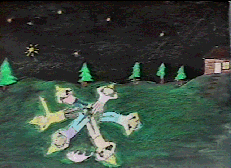
We were all laying back looking at the beautiful stars when somebody asked
the brightest star a question:
"How old are you, Mister Star?"
Suddenly, in a grandfather-like voice, the star answered
back:
"A lot older than you kids!"
I'm 15 billion years old!"
WOW ! ! !, we all yelled.
After that, someone asked another question:
"Have you ever had a birthday party?"
"Of course!" This is my birthday party too!"
"Ehhhhhh!," we all yelled.
The bright star continued,
"That's right! Our birthdays are connected!
If you want to see, I can show you.
But this is a long birthday adventure.
Are you sure you want to go?"
"Yes!" (Hai!), everyone yelled.
LET'S GO! ! !
(Ikimasyou!)
Where do you think the star is going to take us?
We'll come back later and find out!
(end of part I)
(part II)
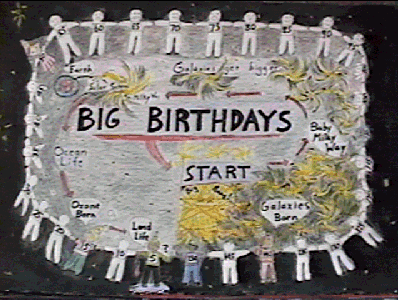
Mister Star led us on a birthday adventure to show us how our birthdays are connected.
Suddenly the six of us were standing in a "Big Birthdays" room with 24 space ghosts! With our hands joined, we made a circle of 30. Then Mister Star began talking to us:
"Do you remember how, at your birthday party, you discovered there were the same number of people in the room as your new age? You gave a year to each person in the room to make six years."
"Yes we remember!"
"Well, since I'm 15 billion years old, and we
have 30 people in the room, we'll give each person 500 million years to make the
total!"
Now, with this circle of thirty people,
I'm going to show you how our birthdays are connected.
Are you ready?!"
"Let's start with the first and biggest birthday, 15 billion years ago. That birthday was SO big, some people call it the B-I-G -- B-A-N-G ! ! We don't know how it all started but it must have been more powerful than anything we can imagine!"
"At this time, everything in the space we live in flared forth like fireworks in all
directions! And it's STILL expanding today!
Nothing would not be here today
without this big birthday!
What do you think gave birth to it all?
"Hmmmm . . . "
"It makes me wonder too, but we've got to keep going with the birthday party now!"
"Let's see how long it takes to get
to the next big birthday in the circle, counting from the Big Bang:
First (Ichi-ban mei no hito) . . . . Second
(Ni-ban) . . . Third (San-ban)
. . . Fourth (Yon-ban) . . . Fifth (Go-ban)
. . . Sixth (Roku-ban) . . .
Seventh (Nana-ban) . . . Eighth (Hachi-ban)
. . . Ninth (Kyu-ban) . . . "
"Whoa! Stop, there's our galaxy, the Milky
Way (Amano-gawa), when it was just born! Your solar system and earth have not even been born yet!"
You know until we see their birthday, we can't even have our party today!
Let's see how many more people it takes until the earth and solar system are
born.
Let's continue: Ninth (Kyu-ban), . . .
Tenth (Jyuu-ban), . . . Eleventh (Jyu-ichi-ban).
. . Twenty-first (Ni-jyuu-ichi).
Whoah! Stop! It's all the way to the twenty-first person!
That's when our solar system was born from a star even bigger than our sun.
That birthday was SO BIG we call it a Super Nova!"
And because of that, all of the planets and our sun were born!
The earth was born, and there was life soon after, but life could still not
survive on the land like it can today. That's because the dangerous parts of the sunshine were still
reaching the earth. It was still too dangerous!
Life needed a protective shield called the Ozone for
life to get protection and survive on land. And that took a LONG time -- seven
more people in the circle. Thanks to the earth's ocean life that gave lots of
oxygen, the Ozone Layer was finally born at the 28th person -- that's four-and-a-half billion
years ago.
Let's zoom-in on the last person to see how life took shape in the last 500 million years on the land where we live now.
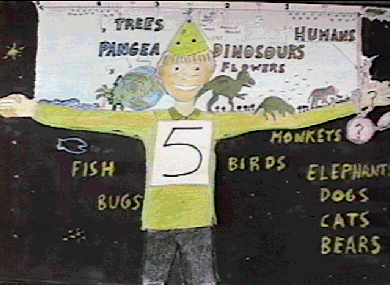
Everyone take a look at your arm and I'll show how we divide the last 500 million years in to five parts." "Wrist to elbow (that's 500 to 400), elbow to shoulder (that's 400 to 300), shoulder to shoulder (that's 300 to 200), shoulder to elbow (that's 200 to 100), and elbow to wrist (that's 100 to today!). Do you see the five parts? "
"Yes!" we yelled.
"Let's see what happened during this time:
(end of part II)
(part III)
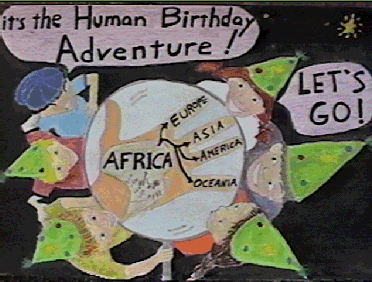
"Wow, compared to the rest of the story humans have only been here for a
really short time!" everyone
said.
"That's right, said Mister Star. Let's see how human birthdays
are connected and how our different faces came to the way they look today!"
"If you magnify the last centimeter where humans were born, you can see
the human birthday adventure. This adventure is from the time when humans were
born until now!
For the first half of the adventure, it looks like Africa was everyone's home!
This was the biggest, warmest place to be on the world, so it's no wonder. From
there humans
moved all over the rest of the land in the world: Europe, Asia, the Americas, and Oceania.
Shall we visit Africa, to see how we all got going around the world?"
"Yes, let's go!"
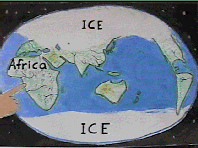
Why do you think humans lived in Africa for so long?
It's probably because the rest of the earth was still too cold. Around 5 million years ago, ice often covered most of the northern and southern parts of the earth. Only the earth's equator was warm enough for humans to live. Africa is still the biggest equatorial land mass on the planet and back then it was a lot greener than it is today.
"I wonder what our family was like
then?," someone
asked.
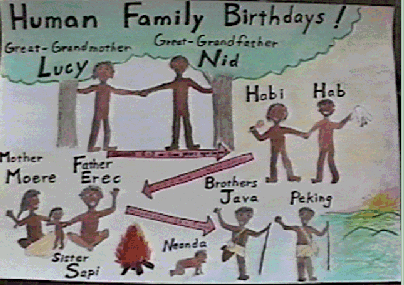
Scientists call the oldest human family name Hominids and they were born around 5 million years ago. They liked vegetables and fruit, but they did not eat meat. Can you imagine Great-Grandmother Lucy and Great-Grandfather Nid Hominid ? !
The next generation in the human family
were the Homohabilis.
Can you imagine Grandmother Habi and
Grandfather Hab -- born about 2 million years ago. They liked eating fruits and
vegetables, but they
liked eating meat too.
Which do you like better, fruit or meat?
The next generation in the family
were the Homoerectus people.
Can you imagine Mother Moere, Father
Erec, born about 1.5 million years ago.
And they had some children about 500,000 years ago: Big brothers Java and Peking,
a daughter little sister Sapi 130,000 years ago, and baby Neanda about 100,000
ago. These kids could eat anthing, they were all real smart and they loved to
travel. They liked to take long walks and go hiking over the mountians and
they'd hardly ever get tired. Do you like to take long walks or go hiking in the
mountains?
Where do you think they walked?
Find Peking,
Java, and Neanda valley in Europe on the globe.
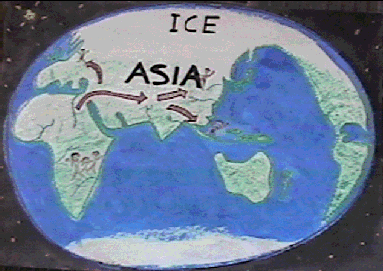
Mother Moer, Father Erec and Sister Sapi stayed home in Africa. And
they began to worry about the boys because the Earth's ice was beginning to grow again.
But the boys never came home again!
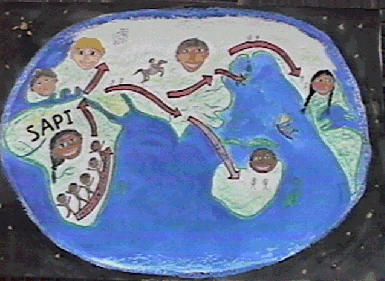
Even after little sister Sapi became a mother, she still
worried about her brothers Neanda, Peking, and Java. So, she decided to have lots of
children and send them in search of her brothers. By this time, the ice was melting again
and Sapi's children were able to travel all over the world.
Over thousands of years, Sapi's
children and grandchildren's skin color and eye shape began to change depending on the
land and weather where they lived.
That's how our faces and bodies came to look the way they do
today and that's still why every person on the earth has special qualities.
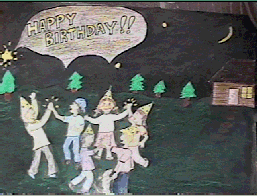
Are you starting to see how our birthdays are connected?
Yeah! So when you celebrate one birthday, you really are celebrating all of the birthdays that ever were! Thank you for taking us on this great birthday adventure!
Mister Star laughed and said, "It was fun! See you next year!"
Everyone did high fives and said "Happy Birthday,
Everyone!"
![]()